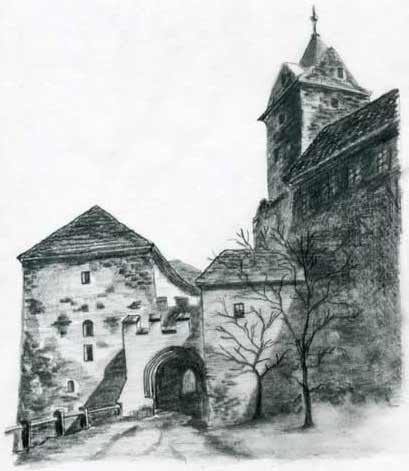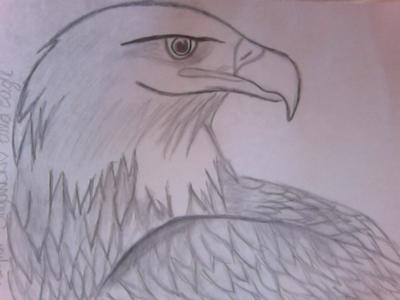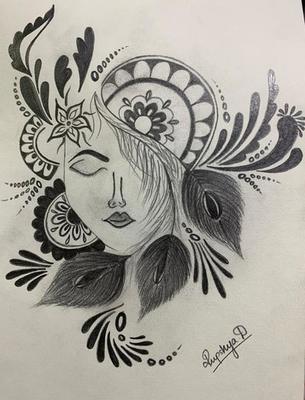Castle Drawings

I am very happy you are interested in castle drawings and my special thanks to you that you are here. Welcome to medieval Europe. This is a very interesting and very mysterious topic full of unexpected things. Drawing castles allows you to use your fantasy.
For me, castles equal history in “real estate”. So many stories, human dramas, tragedies end legends are hidden behind their thick 900 years old stonewall.
Many of them are only ruins, but just imagine how real people built them. I can hardly explain by words the goosebumps, the feeling you experience when you are there when the giant soars right before you.
I am lucky to be born in central Europe where medieval castles are sprinkled throughout the countryside. It offers you countless opportunities for castle drawings.
Very nice pictures to copy are old drawings, carvings, or lithographs. They are simple but have the power to convey the reality from those ages.
Enjoy The Castle Drawings
On the picture above is a simple and rather easy-to-copy castle drawing of the entrance gate area.
It is in fact very real, just as if you are about to enter the castle. Click on the picture to enlarge, it will open in a new tab or window. Print it out and let’s go to the next step.
Draw a weak pencil outline of the castle’s main features or simply trace it by tracing paper. Start from the left side if possible. Draw the roof, small arrow loop openings on the lower building – turret.
The gate has a Gothic-style opening, so it might be that the castle was built in that period. Also, make markings of damaged parts of the walls; we shall shade them darker or point out the building stones.
This work is very helpful and necessary because you will have the total outline and the shape of the castle drawing ready so that you can concentrate on the “coloring – shading - work”.
Start the shading work from whichever part you like. I did it from the top right tower.
Since this is a pencil drawing, use a piece of paper under your right hand (karate chop part) that directly touches the drawing paper, not to smudge the drawing.
See that the roof tiles on the building right under the tower are wavy shaped, so make wavy lines to create a more realistic drawing.
The wall of the building on the right under the tower is in shade, it is dark and you need not put much attention to details.
However, the windows should be slightly featured. They are weakly visible but they are there. It is enough to just roughly sketch these shady darker parts.
The most visible wall is the lower building – turret on the left side, left from the entrance gate. There we shall pay a little more attention and work it out nicely.
Use your fantasy. The symmetry of the building should be obeyed but the parts where the building stones are visible can be virtually anywhere. Mostly are visible on the corners.
Similarly, shade the rest of the buildings. Be careful, however, while shading the roofs. Roof tiles should be pointed out. You can smudge them by cotton swab later but the shape should indicate that it is a roof. Your drawing will look much better.
The gate still remains white; we shall shade it in the next step. Notice, however, that the sunlight is coming from the right side. Therefore the shade of the entrance gate part is visible on the turret wall on the left.
Similarly, the diagonal shadow is cast on the turret on the right side of the gate. Guard rails on the left side of the road were probably built recently. You can draw them but need not if you don’t want to.
The last step is to finish the gate itself. Pay special attention to the visible folds on the left side of the Gothic gate opening. This gate seems like some short tunnel so shade it just dark as you see in the picture.
Again, use your fantasy wherever possible. I did not draw leaves on the trees in front of the right side turret but you can do so and, your castle will look like a summer drawing. You can also add clouds or ravens or whatever. Use your fantasy.
These types of castle drawings can be well made in sepia color so that they will be even more impressive and more authentic – “old-looking”.
Corroy Le Chateau - Belgium
This is a beautiful medieval castle in Belgium built around 1270 by the Count Philippe of Vianden and his wife Mary of Brabant. I like this scenery very much and I couldn’t help but draw the castle.
This drawing may look a bit more complex but it only looks like that. It is very helpful to just “decompose” the drawing into smaller parts like the tower, gate, bridge…etc. Such imagination technique will help you not to be scared when you suddenly see a complex object.
I showed and explained in detail this decomposing technique in drawing carnation section. you can apply this technique to virtually any object not only on carnations or castle drawings.
It is good to keep in mind that most of the castles are medieval architectural objects, which are usually complex for several reasons. Castles were usually built on the top of the hill - mostly rocky hills.
Such terrain does not provide many building options so the builders had to utilize every possible piece of ground or rock. They could not adjust much the ground; instead, they had to adjust the shape of the building complex.
Yes there are plenty of castles built on the flat land and these castles were probably built in more or less symmetry and, thus they are easier to draw.
Many of the castle drawings that I would like to introduce to you are medieval, top-of-the-hill-built buildings. You can find these castles in many places throughout Europe. Many of them are only ruins but you can often find the rest of the original majesty in the ruins as well.
Draw the outline of the castle by simple and weak pencil line. You can use HB sharp pencil for the initial outline drawing so that you can keep the same thickness of the line all the time. Draw by free hand, do not use a ruler!
When you have ready the outlines we can start to shade each building from left to the right, or from right to the left if you are left-handed.
Please use a piece of paper under the palm of your drawing hand that rests on the paper while you work, not to blur your drawing.
When we draw architectural objects like castle drawings, we usually decide where the sunshine or the daylight source will be coming from. In this case, it is from the upper right corner.
This is something you can easily get accustomed to. Based on the daylight source you will know how to shade the castle’s buildings. Very simple ideas about how to shade any object are in the warming up exercise section.
Click on the images to enlarge and see how I worked out the parts of the castle. I used simple strokes (as usual), crossing or lining up on each other to get a darker tone.
When you draw the roof pattern, just shade the roof first, and then with a sharp pencil, make crossing lines resembling the roof tiles. Draw these lines gently, they must look almost like a shade. A good example of roof tiles is the gate-roof on this castle It should look like this or better.
Castles are stone-built. You can emphasize the visibility of the stones on your castle drawings by short simple pencil strokes around the corner areas on the walls.
One of the best ways of marking the stones is by the flattened tip of the pencil. This method works well for me, so I recommend it because it allows you to draw these “stone-details” fast and easily.
Prague - Czech Republic
The following pictures may seem a bit complex. They are not exactly castle drawings. It is the view of the scenery from Prague’s Charles Bridge. This historical architectural mix is beautiful. It is located right under Prague’s Castle.
Because of this “too much complexity,” I decided to copy – to trace first the silhouettes and outlines. To create a so-called “coloring page” base, although the only color that I used was a standard graphite pencil.
On this drawing, you see half of the picture is ready with all details and half is still only silhouettes. It is quite a tedious work, drawing all details on those historical buildings but the final effect is good.
This picture took me about 2 hours to draw only the silhouettes first. I did it in one evening. The next day it took another 5 hours to fill up all details. I made it all with an HB pencil.
Hope you like it.
It is a good exercise to also draw old town scenery instead of castle drawings.
Visitors Personal Gallery Pages
Please see and enjoy the following collection of personal galleries. We all believe you will have a lot of fun. Observing others’ artwork is always, always very inspirational. You may get some new ideas for your own drawings.
|
| |||
Theme Based Visitors Galleries
The following Theme Based Galleries are a collection of selected drawings from various authors based on a certain theme. I would like you to get as much inspiration as possible for your own drawings.
And Now It's Your Turn
SHARE YOUR DRAWINGS
Select The Category and Follow The Uploading Instructions
Share your own drawings, sketches or doodles by choosing a suitable
category below. You will be guided to the uploading process step by
step.
Latest Visitor's Drawings
-
Loneliness
Jul 20, 24 08:03 PM
Loneliness -
A macho man kills a poisonous snake
Jul 18, 24 09:15 AM
A macho man kills a poisonous snake. -
Jude Bellingham
Jul 15, 24 09:01 AM
This is my method of drawing an Englishman Jude Bellingham on Microsoft Paint. He was born in Stourbridge, West Midlands, England, United Kingdom on 29th -
Fatty people are stupid fellows
Jul 14, 24 08:46 AM
Fatty people are stupid fellows. -
Face the present time
Jul 14, 24 08:45 AM
Face the present time. -
cricket
Jul 02, 24 04:26 PM
cricket -
Three Generations: Grandfather, Father and Son
Jun 26, 24 05:52 PM
Three Generations: Grandfather, Father and Son -
The Shapers heads
Jun 26, 24 07:23 AM
This is my drawing of the Shapers heads for the fake Nickelodeon animated series of the same name on Microsoft Paint. In order, they're Purple Square, -
Where nature dominates
Jun 24, 24 09:26 AM
Imaginary ballpoint pens art. In this fast and furious world dominated with pollution and skycrapers, we need this type of peacable place for anti-stress -
Never argue with the barking dogs
Jun 24, 24 09:23 AM
Never argue with the barking dogs. -
Imaginary pen art on bristol paper
Jun 22, 24 07:28 AM
Colourful nature done with ballpoint pens. -
Imaginary pen art, beautiful nature
Jun 22, 24 07:22 AM
Ballpoint pens art showing a peaceful place. The grass was made with light green pen and application of lemon yellow watercolour. -
Old building in forest
Jun 22, 24 07:20 AM
Imaginary ballpoint pens art. An old building in a forest. -
Typical Mauritius
Jun 22, 24 07:19 AM
Imaginary ballpoint pens art showing typical Mauritius. -
Inspired by Mumbai city
Jun 22, 24 07:16 AM
Some years back was watching a video about Mumbai city. Inspired by it, I decided to make an imaginary art showing the atmosphere of it.












































































